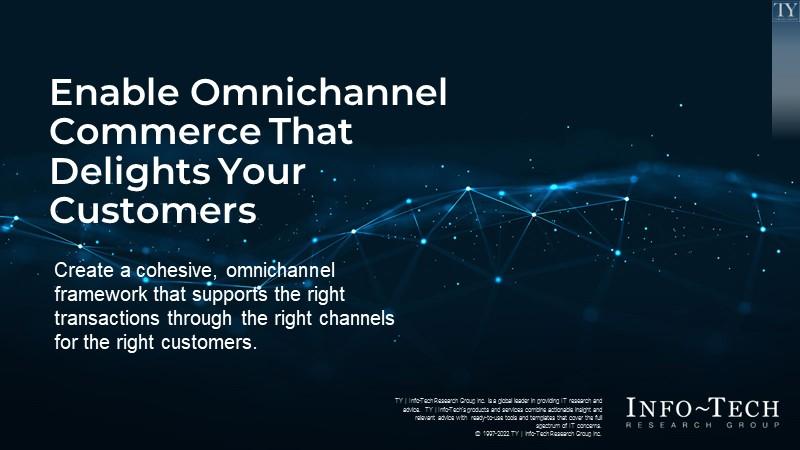
Enable Omnichannel Commerce That Delights Your Customers
- Today’s customers expect to be able to transact with you in the channels of their choice. The proliferation of e-commerce, innovations in brick-and-mortar retail, and developments in mobile commerce and social media selling mean that IT organizations are managing added complexity in drafting a strategy for commerce enablement.
- The right technology stack is critical in order to support world-class e-commerce and brick-and-mortar interactions with customers.
Our Advice
Critical Insight
- Support the right transactional channels for the right customers: there is no “one-size-fits-all” approach to commerce enablement – understand your customers to drive selection of the right transactional channels.
- Don’t assume that “traditional” commerce channels have stagnated: IoT, customer analytics, and blended retail are reinvigorating brick-and-mortar selling.
- Don’t buy best-of-breed; buy best-for-you. Base commerce vendor selection on your requirements and use cases, not on the vendor’s overall performance.
Impact and Result
- Leverage Info-Tech’s proven, road-tested approach to using personas and scenarios to build strong business drivers for your commerce strategy.
- Before selecting and deploying technology solutions, create a cohesive channel matrix outlining which channels your organization will support with transactional capabilities.
- Understand evolving trends in the commerce solution space, such as AI-driven product recommendations and integration with other essential enterprise applications (i.e. CRM and marketing automation platforms).
- Understand and apply operational best practices such as content optimization and dynamic personalization to improve the conversion rate via your e-commerce channels.
Enable Omnichannel Commerce That Delights Your Customers Research & Tools
Besides the small introduction, subscribers and consulting clients within this management domain have access to:
1. Enable Omnichannel Commerce Deck – A deck outlining the importance of creating a cohesive omnichannel framework to improve your customer experience.
E-commerce channels have proliferated, and traditional brick-and-mortar commerce is undergoing reinvention. In order to provide your customers with a strong experience, it's imperative to create a strategy – and to deploy the right enabling technologies – that allow for robust multi-channel commerce. This storyboard provides a concise overview of how to do just that.
- Enable Omnichannel Commerce That Delights Your Customers – Phases 1-2
2. Create Personas to Drive Omnichannel Requirements Template – A template to identify key customer personas for e-commerce and other channels.
Customer personas are archetypal representations of your key audience segments. This template (and populated examples) will help you construct personas for your omnichannel commerce project.
- Create Personas to Drive Omnichannel Requirements Template
Further reading
Enable Omnichannel Commerce That Delights Your Customers
Create a cohesive, omnichannel framework that supports the right transactions through the right channels for the right customers.
Analyst Perspective
A clearly outlined commerce strategy is a necessary component of a broader customer experience strategy.

Ben Dickie
Research Lead, Research – Applications
Info-Tech Research Group
“Your commerce strategy is where the rubber hits the road, converting your prospects into paying customers. To maximize revenue (and provide a great customer experience), it’s essential to have a clearly defined commerce strategy in place.
A strong commerce strategy seeks to understand your target customer personas and commerce journey maps and pair these with the right channels and enabling technologies. There is not a “one-size-fits-all” approach to selecting the right commerce channels: while many organizations are making a heavy push into e-commerce and mobile commerce, others are seeking to differentiate themselves by innovating in traditional brick-and-mortar sales. Hybrid channel design now dominates many commerce strategies – using a blend of e-commerce and other channels to deliver the best-possible customer experience.
IT leaders must work with the business to create a succinct commerce strategy that defines personas and scenarios, outlines the right channel matrix, and puts in place the right enabling technologies (for example, point-of-sale and e-commerce platforms).”
Stop! Are you ready for this project?
This Research Is Designed For:
- IT leaders and business analysts supporting their commercial and marketing organizations in developing and executing a technology enablement strategy for e-commerce or brick-and-mortar commerce.
- Any organization looking to develop a persona-based approach to identifying the right channels for their commerce strategy.
This Research Will Help You:
- Identify key personas and customer journeys for a brick-and-mortar and/or e-commerce strategy.
- Select the right channels for your commerce strategy and build a commerce channel matrix to codify the results.
- Review the “art of the possible” and new developments in brick-and-mortar and e-commerce execution.
This Research Will Also Assist:
- Sales managers, brand managers, and any marketing professional looking to build a cohesive commerce strategy.
- E-commerce or POS project teams or working groups tasked with managing an RFP process for vendor selection.
This Research Will Help Them:
- Build a persona-centric commerce strategy.
- Understand key technology trends in the brick-and-mortar and e-commerce space.
Executive Summary
Your Challenge
Today’s customers expect to be able to transact with you in the channels of their choice.
The proliferation of e-commerce, innovations in brick-and-mortar retail, and developments in mobile commerce and social media selling mean that IT organizations are managing added complexity in drafting a strategy for commerce enablement.
The right technology stack is critical to support world-class e-commerce and brick-and-mortar interactions with customers.
Common Obstacles
Many organizations do not define strong, customer-centric drivers for dictating which channels they should be investing in for transactional capabilities.
As many retailers look to move shopping experiences online during the pandemic, the impetus for having a strong e-commerce suite has markedly increased. The proliferation of commerce vendors has made it difficult to identify and shortlist the right solution, while the pandemic has also highlighted the importance of adopting new vendors quickly and efficiently: companies need to understand the top players in different commerce market landscapes.
IT is receiving a growing number of commerce platform requests and must be prepared to speak intelligently about requirements and the “art of the possible.”
Info-Tech’s Approach
- Leverage Info-Tech’s proven, road-tested approach to using personas and scenarios to build strong business drivers for your commerce strategy.
- Before selecting and deploying technology solutions, create a cohesive channel matrix outlining which channels your organization will support with transactional capabilities.
- Understand evolving trends in the commerce solution space, such as AI-driven product recommendations and integration with other essential enterprise applications (i.e. customer relationship management [CRM] and marketing automation platforms).
- Understand and apply operational best practices such as content optimization and dynamic personalization to improve the conversion rate via your e-commerce channels.
Info-Tech Insight
- Support the right transactional channels for the right customers: there is no “one-size-fits-all” approach to commerce enablement – understand your customers to drive selection of the right transactional channels.
- Don’t assume that “traditional” commerce channels have stagnated: IoT, customer analytics, and blended retail are reinvigorating brick-and-mortar selling.
- Don’t buy best-of-breed; buy best-for-you: base commerce vendor selection on your requirements and use cases, not on the vendor’s overall performance.
A strong commerce strategy is an essential component of a savvy approach to customer experience management
A commerce strategy outlines an organization’s approach to selling its products and services. A strong commerce strategy identifies target customers’ personas, commerce journeys that the organization wants to support, and the channels that the organization will use to transact with customers.
Many commerce strategies encompass two distinct but complementary branches: a commerce strategy for transacting through traditional channels and an e-commerce strategy. While the latter often receives more attention from IT, it still falls on IT leaders to provide the appropriate enabling technologies to support traditional brick-and-mortar channels as well. Traditional channels have also undergone a digital renaissance in recent years, with forward-looking companies capitalizing on new technology to enhance customer experiences in their stores.
Traditional Channels
- Physical Stores (Brick and Mortar)
- Kiosks or Pop-Up Stores
- Telesales
- Mail Orders
- EDI Transactions
E-Commerce Channels
- E-Commerce Websites
- Mobile Commerce Apps
- Embedded Social Shopping
- Customer Portals
- Configure Price Quote Tool Sets (CPQ)
- Hybrid Retail
Info-Tech Insight
To better serve their customers, many companies position themselves as “click-and-mortar” shops – allowing customers to transact at a store or online.
Customers’ expectations are on the rise: meet them!
Today’s consumers expect speed, convenience, and tailored experiences at every stage of the customer lifecycle. Successful organizations strive to support these expectations.
58%
of retail customers admitted that their expectations now are higher than they were a year ago (FinancesOnline).
70%
of consumers between the ages of 18 and 34 have increasing customer expectations year after year (FinancesOnline).
69%
of consumers now expect store associates to be armed with a mobile device to deliver value-added services, such as looking up product information and checking inventory (V12).
73%
of support leaders agree that customer expectations are increasing, but only…
42%
of support leaders are confident that they’re actually meeting those expectations.
How can you be sure that you are meeting your customers’ expectations?
- Offer more personalization throughout the entire customer journey
- Practice quality customer service – ensure staff have up-to-date knowledge and offer quick resolution time for complaints
- Focus on offering low-effort experiences and easy-to-use platforms (i.e. “one-click buying”)
- Ensure your products and services perform well and do what they’re meant to do
- Ensure omnichannel availability – 9 in 10 consumers want a seamless omnichannel experience
Info-Tech Insight
Customers expect to interact with organizations through the channels of their choice. Now more than ever, you must enable your organization to provide tailored commerce and transactional experiences.
Omnichannel commerce is the way of the future
Create a strategy that embraces this reality with the right tools!
Get ahead of the competition by doing omnichannel right! Devise a strategy that allows you to create and maintain a consistent, seamless commerce experience by optimizing operations with an omnichannel framework. Customers want to interact with you on their own terms, and it falls to IT to ensure that applications are in place to support and manage both traditional and e-commerce channels. There must also be consistency of copy, collateral, offers, and pricing between commerce channels.
71%
of consumers want a consistent experience across all channels, but only…
29%
say that they actually get it.
(Source: Business 2 Community, 2020)
Omnichannel is a “multichannel approach that aims to provide customers with a personalized, integrated, and seamless shopping experience across diverse touchpoints and devices.”
Source: RingCentral, 2021
IT is responsible for providing technology enablement of the commerce strategy: e-commerce platforms are a cornerstone
An e-commerce platform is an enterprise application that provides end-to-end capabilities for allowing customers to purchase products or services from your company via an online channel (e.g. a traditional website, a mobile application, or an embedded link in a social media post). Modern e-commerce platforms are essential for delivering a frictionless customer journey when it comes to purchasing online.
$6.388
trillion dollars worth of sales will be conducted online by 2024 (eMarketer, 14 Jan. 2021).
44%
of all e-commerce transactions are expected to be completed via a mobile device by 2024 (Insider).
21.8%
of all sales will be made from online purchases by 2024 (eMarketer, 14 Jan. 2021).
Strong E-Commerce Platforms Enable a Wide Range of Functional Areas:
- Product Catalog Management
- Web Content Delivery
- Product Search Engine
- Inventory Management
- Shopping Cart Management
- Discount and Coupon Management
- Return Management and Reverse Logistics
- Dynamic Personalization
- Dynamic Promotions
- Predictive Re-Targeting
- Predictive Product Recommendations
- Transaction Processing
- Compliance Management
- Commerce Workflow Management
- Loyalty Program Management
- Reporting and Analytics
An e-commerce solution boosts the effectiveness and efficiency of your operations and drives top-line growth
Take time to learn the capabilities of modern e-commerce applications. Understanding the “art of the possible” will help you to get the most out of your e-commerce platform.
An e-commerce platform helps marketers and sales staff in three primary ways:
- It allows the organization to effectively and efficiently operate e-commerce operations at scale.
- It allows commercial staff to have a single system for managing and monitoring all commercial activity through online channels.
- It allows the organization to improve the customer-facing e-commerce experience, boosting conversions and top-line sales.
A dedicated e-commerce platform improves the efficiency of customer-commerce operations
- Workflow automation reduces the amount of time spent executing dynamic e-commerce campaigns.
- The use of internal or third-party data increases conversion effectiveness from customer databases across the organization.
Info-Tech Insight
A strong e-commerce provides marketers with the data they need to produce actionable insights about their customers.
Case Study
INDUSTRY - Retail
SOURCE - Salesforce (a)
PetSmart improves customer experience by leveraging a new commerce platform in the Salesforce ecosystem
PetSmart
PetSmart is a leading retailer of pet products, with a heavy footprint across North America. Historically, PetSmart was a brick-and-mortar retailer, but it has placed a heavy emphasis on being a true multi-channel “click-and-mortar” retailer to ensure it maintains relevance against competitors like Amazon.
E-Commerce Overhaul Initiative
To improve its e-commerce capabilities, PetSmart recognized that it needed to consolidate to a single, unified e-commerce platform to realize a 360-degree view of its customers. A new platform was also required to power dynamic and engaging experiences, with appropriate product recommendations and tailored content. To pursue this initiative, the company settled on Salesforce.com’s Commerce Cloud product after an exhaustive requirements definition effort and rigorous vendor selection approach.
Results
After platform implementation, PetSmart was able to effortlessly handle the massive transaction volumes associated with Black Friday and Cyber Monday and deliver 1:1 experiences that boosted conversion rates.
PetSmart standardized on the Commerce Cloud from Salesforce to great effect.
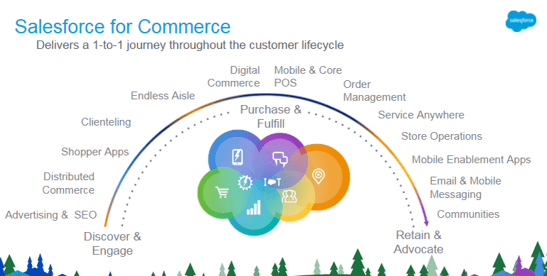
Case Study
Icebreaker exceeds customer expectations by using AI to power product recommendations
INDUSTRY - Retail
SOURCE - Salesforce (b)
Icebreaker
Icebreaker is a leading outerwear and lifestyle clothing company, operating six global websites and owning over 5,000 stores across 50 countries. Icebreaker is focused on providing its shoppers with accurate, real-time product suggestions to ensure it remains relevant in an increasingly competitive online market.
E-Commerce Overhaul Initiative
To improve its e-commerce capabilities, Icebreaker recognized that it needed to adopt a predictive recommendation engine that would offer its customers a more personalized shopping experience. This new system would need to leverage relevant data to provide both known and anonymous shoppers with product suggestions that are of interest to them. To pursue this initiative, Icebreaker settled on using Salesforce.com’s Commerce Cloud Einstein, a fully integrated AI.
Results
After integrating Commerce Cloud Einstein on all its global sites, Icebreaker was able to cross-sell and up-sell its merchandise more effectively by providing its shoppers with accurate product recommendations, ultimately increasing average order value.
IT must also provide technology enablement for other channels, such as point-of-sale systems for brick-and-mortar
Point-of-sale systems are the “real world” complement to e-commerce platforms. They provide functional capabilities for selling products in a physical store, including basic inventory management, cash register management, payment processing, and retail analytics. Many firms struggle with legacy POS environments that inhibit a modern customer experience.
$27.338
trillion dollars in retail sales are expected to be made globally in 2022 (eMarketer, 2022).
84%
of consumers believe that retailers should be doing more to integrate their online and offline channels (Invoca).
39%
of consumers are unlikely or very unlikely to visit a retailer’s store if the online store doesn’t provide physical store inventory information (V12).
Strong Point-of-Sale Platforms Enable a Wide Range of Functional Areas:
- Product Catalog Management
- Discount Management
- Coupon Management and Administration
- Cash Management
- Cash Register Reconciliation
- Product Identification (Barcode Management)
- Payment Processing
- Compliance Management
- Basic Inventory Management
- Commerce Workflow Management
- Exception Reporting and Overrides
- Loyalty Program Management
- Reporting and Analytics
E-commerce and POS don’t live in isolation
They’re key components of a well-oiled customer experience ecosystem!
Integrate commerce solutions with other customer experience applications – and with ERP or logistics systems – to handoff transactions for order fulfilment.
Having a customer master database – the central place where all up-to-the-minute data on a customer profile is stored – is essential for traditional and e-commerce success. Typically, the POS or e-commerce platform is not the system of record for the master customer profile: this information lives in a CRM platform or customer data warehouse. Conceptually, this system is at the center of the customer-experience ecosystem.
Strong POS and e-commerce solutions orchestrate transactions but typically do not do the heavy lifting in terms of order fulfilment, shipping logistics, economic inventory management, and reverse logistics (returns). In an enterprise-grade environment, these activities are executed by an enterprise resource planning (ERP) solution – integrating your commerce systems with a back-end ERP solution is a crucial step from an application architecture point of view.
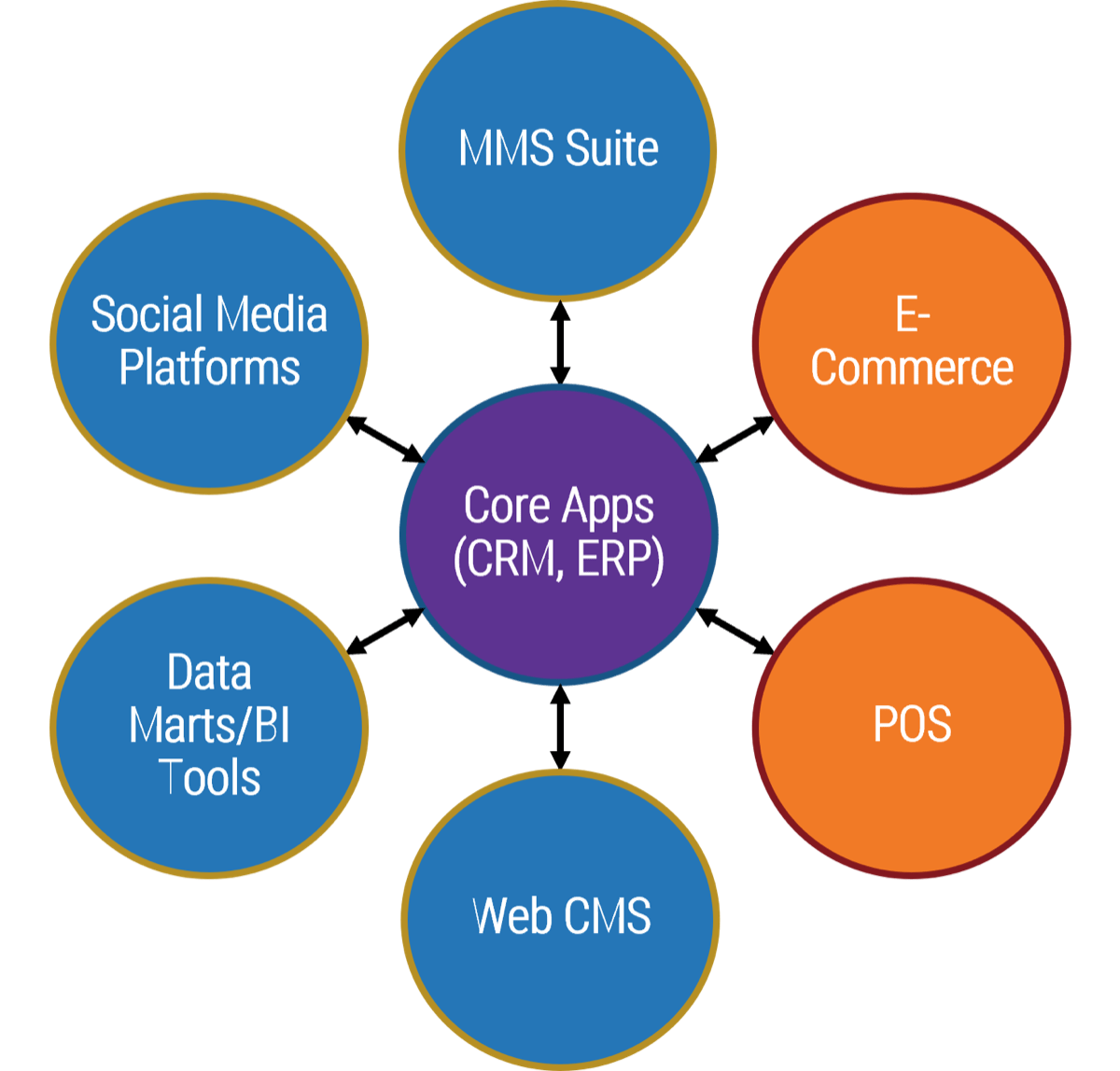
Case Study
INDUSTRY - Retail
SOURCES - Amazon, n.d. CNET, 2020
Amazon is creating a hybrid omnichannel experience for retail by introducing innovative brick-and-mortar stores
Amazon
Amazon began as an online retailer of books in the mid-1990s, and rapidly expanded its product portfolio to nearly every category imaginable. Often hailed as the foremost success story in online commerce, the firm has driven customer loyalty via consistently strong product recommendations and a well-designed site.
Bringing Physical Retail Into the Digital Age
Beginning in 2016 (and expanding in 2018), Amazon introduced Amazon Go, a next-generation grocery retailer, to the Seattle market. While most firms that pursue an e-commerce strategy traditionally come from a brick-and-mortar background, Amazon upended the usual narrative: the world’s largest online retailer opening physical stores to become a true omnichannel, “click-and-mortar” vendor. From the get-go, Amazon Go focused on innovating the physical retail experience – using cameras, IoT capabilities, and mobile technologies to offer “checkout-free” virtual shopping carts that automatically know what products customers take off the shelves and bill their Amazon accounts accordingly.
Results
Amazon received a variety of industry and press accolades for re-inventing the physical store experience and it now owns and operates seven separate store brands, with more still on the horizon.
Case Study
INDUSTRY - Retail
SOURCES - Glossy, 2020
Old Navy
Old Navy is a clothing and accessories retail company that owns and operates over 1,200 stores across North America and China. Typically, Old Navy has relied on using traditional marketing approaches, but recently it has shifted to producing more digitally focused campaigns to drive revenue.
Bringing Physical Retail Into the Digital Age
To overcome pandemic-related difficulties, including temporary store closures, Old Navy knew that it had to have strong holiday sales in 2020. With the goal of stimulating retail sales growth and maximizing its pre-existing omnichannel capabilities, Old Navy decided to focus more of its holiday campaign efforts online than in years past. With this campaign centered on connected TV platforms, such as Hulu, and social media channels including Facebook, Instagram, and TikTok, Old Navy was able to take a more unique, fun, and good-humored approach to marketing.
Results
Old Navy’s digitally focused campaign was a success. When compared with third quarter sales figures from 2019, third quarter net sales for 2020 increased by 15% and comparable sales increased by 17%.
Info-Tech offers various levels of support to best suit your needs
DIY Toolkit
“Our team has already made this critical project a priority, and we have the time and capability, but some guidance along the way would be helpful.”
Guided Implementation
“Our team knows that we need to fix a process, but we need assistance to determine where to focus. Some check-ins along the way would help keep us on track.”
Workshop
“We need to hit the ground running and get this project kicked off immediately. Our team has the ability to take this over once we get a framework and strategy in place.”
Consulting
“Our team does not have the time or the knowledge to take this project on. We need assistance through the entirety of this project.”
Diagnostics and consistent frameworks used throughout all four options
Guided Implementation
What does a typical GI on this topic look like?
| Phase 1 | Phase 2 | Phase 3 | Phase 4 | Phase 5 |
|---|---|---|---|---|
Call #1: Scope requirements, objectives, and your specific challenges. |
Call #2: Assess current maturity. |
Call #4: Identify relationship between current initiatives and capabilities. |
Call #6: Identify strategy risks. | Call #8: Identify and prioritize improvements. |
Call #3: Identify target-state capabilities. |
Call #5: Create initiative profiles. |
Call #7: Identify required budget. |
Call #9: Summarize results and plan next steps. |
A Guided Implementation (GI) is a series of calls with an Info-Tech analyst to help implement our best practices in your organization.
A typical GI is between 8 to 12 calls over the course of 4 to 6 months.
Enable Omnichannel Commerce That Delights Your Customers – Project Overview
| 1. Identify Critical Drivers for Your Omnichannel Commerce Strategy | 2. Map Drivers to the Right Channels and Technologies | |
|---|---|---|
| Best Practice Toolkit | 1.1 Assess Personas and Scenarios 1.2 Create Key Drivers and Metrics |
2.1 Build the Commerce Channel Matrix 2.2 Review Technology and Trends Primer |
| Guided Implementations |
|
|
| Onsite Workshop | Module 1: |
Module 2: |
Identify Critical Drivers for Your Omnichannel Commerce Strategy |
Map Drivers to the Right Channels and Technologies |
|
Phase 1 Outcome: |
Phase 2 Outcome: |
|
An initial shortlist of customer-centric drivers for your channel strategy and supporting metrics. |
A completed commerce channel matrix tailored to your organization, and a snapshot of enabling technologies and trends. |
Phase 1
Identify Critical Drivers for Your Omnichannel Commerce Strategy
1.1 Assess Personas and Scenarios
1.2 Create Key Drivers and Metrics
Enable Omnichannel Commerce That Delights Your Customers
Step 1.1
Assess Personas and Scenarios
This step will walk you through the following activities:
1.1.1 Build key customer personas for your commerce strategy.
1.1.2 Create commerce scenarios (journey maps) that you need to enable.
Identify Critical Drivers for Your Omnichannel Commerce Strategy
This step involves the following participants:
- Business stakeholders (Sales, Marketing)
- IT project team
Outcomes of this step:
- Critical customer personas
- Key traditional and e-commerce scenarios
Use customer personas to picture who will be using your commerce channels and guide scenario design and key drivers
What Are Personas?
Personas are detailed descriptions of the targeted audience of your e-commerce presence. Effective personas:
- Express and focus on the major needs and expectations of the most important user groups.
- Give a clear picture of the typical user’s behavior.
- Aid in uncovering universal features and functionality.
- Describe real people with backgrounds, goals, and values.
Source: Usability.gov, n.d.
Why Are Personas Important?
Personas help:
- Focus the development of commerce platform features on the immediate needs of the intended audience.
- Detail the level of customization needed to ensure content is valuable to the user.
- Describe how users may behave when certain audio and visual stimulus are triggered from the website.
- Outline the special design considerations required to meet user accessibility needs.
Key Elements of a Persona:
- Persona Group (e.g. executives)
- Demographics (e.g. nationality, age, language spoken)
- Purpose of Using Commerce Channels (e.g. product search versus ready to transact)
- Typical Behaviors and Tendencies (e.g. goes to different websites when cannot find products in 20 seconds)
- Technological Environment of User (e.g. devices, browsers, network connection)
- Professional and Technical Skills and Experiences (e.g. knowledge of websites, area of expertise)
Use Info-Tech’s guidelines to assist in the creation of personas
How many personas should I create?
The number of personas that should be created is based on the organizational coverage of your commerce strategy. Here are some questions you should ask:
- Do the personas cover a majority of your revenues or product lines?
- Is the number manageable for your project team to map out?
How do I prioritize which personas to create?
The identified personas should generate the most revenue – or provide a significant opportunity – for your business. Here are some questions that you should ask:
- Are the personas prioritized based on the revenue they generate for the business?
- Is the persona prioritization process considering both the present and future revenues the persona is generating?
Sample: persona for e-commerce platform
Example
Persona quote: “After I call the company about the widget, I would usually go onto the company’s website and look at further details about the product. How am I supposed to do so when it is so hard to find the company’s website on everyday search engines, such as Google, Yahoo, or Bing?”
Michael is a middle-aged manager working in the financial district. He wants to buy the company’s widgets for use in his home, but since he is distrusting of online shopping, he prefers to call the company’s call center first. Afterwards, if Michael is convinced by the call center representative, he will look at the company’s website for further research before making his purchase.
Michael does not have a lot of free time on his hands, and tries to make his free time as relaxing as possible. Due to most of his work being client-facing, he is not in front of a computer most of the time during his work. As such, Michael does not consider himself to be skilled with technology. Once he makes the decision to purchase, Michael will conduct online transactions and pay most delivery costs due to his shortage of time.
Needs:
- Easy-to-find website and widget information.
- Online purchasing and delivery services.
- Answer to his questions about the widget.
- To maintain contact post-purchase for easy future transactions.
Info-Tech Tip
The quote attached to a persona should be from actual quotes that your customers have used when you reviewed your voice of the customer (VoC) surveys or focus groups to drive home the impact of their issues with your company.
1.1.1 Activity: Build personas for your key customers that you’ll need to support via traditional and e-commerce channels
1 hour
- In two to four groups, list all the major, target customer personas that need to be built. In doing so, consider the people who interact with your e-commerce site (or other channels) most often.
- Build a demographic profile for each customer persona. Include information such as age, geographic location, occupation, and annual income.
- Augment the persona with a psychographic profile. Consider the goals and objectives of each customer persona and how these might inform buyer behaviors.
- Introduce your group’s personas to the entire group, in a round-robin fashion, as if you are introducing your persona at a party.
- Summarize the personas in a persona map. Rank your personas according to importance and remove any duplicates.
- Use Info-Tech’s Create Personas to Drive Omnichannel Requirements Template to assist.
Info-Tech Insight
Persona building is typically used for understanding the external customer; however, if you need to gain a better understanding of the organization’s internal customers (those who will be interacting with the e-commerce platform), personas can also be built for this purpose. Examples of useful internal personas are sales managers, brand managers, and customer service directors.
1.1.1 Activity: Build personas for your key customers that you’ll need to support via traditional and e-commerce channels (continued)
Input
- Customer demographics and psychographics
Output
- List of prioritized customer personas
Materials
- Whiteboard
- Markers
Participants
- Project team
Build use-case scenarios to model the transactional customer journey and inform drivers for your commerce strategy
A use-case scenario is a story or narrative that helps explore the set of interactions that a customer has with an organization. Scenario mapping will help identify key business and technology drivers as well as more granular functional requirements for POS or e-commerce platform selection.
A GOOD SCENARIO…
- Describes specific task(s) that need to be accomplished.
- Describes user goals and motivations.
- Describes interactions with a compelling but not overwhelming amount of detail.
- Can be rough, as long as it provokes ideas and discussion.
SCENARIOS ARE USED TO...
- Provide a shared understanding about what a user might want to do and how they might want to do it.
- Help construct the sequence of events that are necessary to address in your user interface(s).
TO CREATE GOOD SCENARIOS…
- Keep scenarios high level, not granular, in nature.
- Identify as many scenarios as possible. If you’re time constrained, try to develop two to three key scenarios per persona.
- Sketch each scenario out so that stakeholders understand the goal of the scenario.
1.1.2 Exercise: Build commerce user scenarios to understand what you want your customers to do from a transactional viewpoint
1 hour
Example
Simplified E-Commerce Workflow Purchase Products
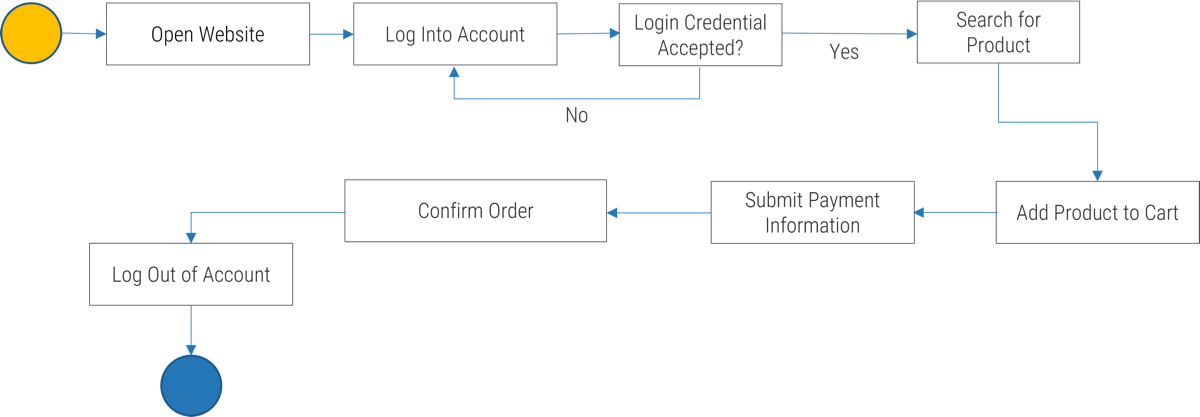
Step 1.2
Create Key Drivers and Metrics
This step will walk you through the following activities:
- Create the business drivers you need to enable with your commerce strategy.
- Enumerate metrics to track the efficacy of your commerce strategy.
Identify Critical Drivers for Your Omnichannel Commerce Strategy
This step involves the following participants:
- Business stakeholders (Sales, Marketing)
- IT project team
Outcomes of this step:
- Business drivers for the commerce strategy
- Metrics and key performance indicators for the commerce strategy
1.2 Finish elaboration of your scenarios and map them to your personas: identify core business drivers for commerce
1.5 hours
- List all commerce scenarios required to satisfy the immediate needs of your personas.
- Does the use-case scenario address commonly felt user challenges?
- Can the scenario be used by those with changing behaviors and tendencies?
- Look for recurring themes in use-case scenarios (for example, increasing average transaction cost through better product recommendations) and identify business drivers: drivers are common thematic elements that can be found across multiple scenarios. These are the key principles for your commerce strategy.
- Prioritize your use cases by leveraging the priorities of your business drivers.
Example

1.2 Finish elaboration of your scenarios and map them to your personas: identify core business drivers for commerce (continuation)
Input
- User personas
Output
- List of use cases
- Alignment of use cases to business objectives
Materials
- Whiteboard
- Markers
Participants
- Business Analyst
- Developer
- Designer
Show the benefits of commerce solution deployment with metrics aimed at both overall efficacy and platform adoption
The ROI and perceived value of the organization’s e-commerce and POS solutions will be a critical indication of the success of the suite’s selection and implementation.
Commerce Strategy and Technology Adoption Metrics |
||
|---|---|---|
EXAMPLE METRICS |
Commerce Performance Metrics |
|
Average revenue per unique transaction |
Quantity and quality of commerce insights |
|
Aggregate revenue by channel |
Unique customers per channel |
|
Savings from automated processes |
Repeat customers per channel |
|
User Adoption and Business Feedback Metrics |
||
User satisfaction feedback |
User satisfaction survey with technology |
|
Business adoption rates |
Application overhead cost reduction |
|
Info-Tech Insight
Even if e-commerce metrics are difficult to track right now, the implementation of a dedicated e-commerce platform brings access to valuable customer intelligence from data that was once kept in silos.
Phase 2
Map Drivers to the Right Channels and Technologies
2.1 Build the Commerce Channel Matrix
2.2 Review Technology and Trends Primer
Enable Omnichannel Commerce That Delights Your Customers
Step 2.1
Build the Commerce Channel Matrix
This step will walk you through the following activities:
- Based on your business drivers, create a blended mix of e-commerce channels that will suit your organization’s and customers’ needs.
Map Drivers to the Right Channels and Technologies
This step involves the following participants:
- Business stakeholders (Sales, Marketing)
- IT project team
Outcomes of this step:
- Commerce channel map
Pick the transactional channels that align with your customer personas and enable your target scenarios and drivers
Traditional Channels |
E-Commerce Channels |
Hybrid Channels |
|---|---|---|
Physical stores (brick and mortar) are the mainstay of retailers selling tangible goods – some now also offer intangible service delivery. |
E-commerce websites as exemplified by services like Amazon are accessible by a browser and deliver both goods and services. |
Online ordering/in-store fulfilment is a model whereby customers can place orders online but pick the product up in store. |
Telesales allows customers to place orders over the phone. This channel has declined in favor of mobile commerce via smartphone apps. |
Mobile commerce allows customers to shop through a dedicated, native mobile application on a smartphone or tablet. |
IoT-enabled smart carts/bags allow customers to shop in store, but check-out payments are handled by a mobile application. |
Mail order allows customers to send (”snail”) mail orders. A related channel is fax orders. Both have diminished in favor of e-commerce. |
Social media embedded shopping allows customers to order products directly through services such as Facebook. |
Info-Tech Insight
Your channel selections should be driven by customer personas and scenarios. For example, social media may be extensively employed by some persona types (i.e. millennials) but see limited adoption in other demographics or use cases (i.e. B2B).
2.1 Activity: Build your commerce channel matrix
30 minutes
- Inventory which transactional channels are currently used by your firm (segment by product lines if variation exists).
- Interview product leaders, sales leaders, and marketing managers to determine if channels support transactional capabilities or are used for marketing and service delivery.
- Review your customer personas, scenarios, and drivers and assess which of the channels you will use in the future to sell products and services. Document below.
Example: Commerce Channel Map
| Product Line A | Product Line B | Product Line C | ||||
|---|---|---|---|---|---|---|
| Currently Used? | Future Use? | Currently Used? | Future Use? | Currently Used? | Future Use? | |
| Store | Yes | Yes | No | No | No | No |
| Kiosk | Yes | No | No | No | No | No |
| E-Commerce Site/Portal | No | Yes | Yes | Yes | Yes | Yes |
| Mobile App | No | No | Yes | Yes | No | Yes |
| Embedded Social | Yes | Yes | Yes | Yes | Yes | Yes |
Input
- Personas, scenarios, and driver
Output
- Channel map
Materials
- Whiteboard
- Markers
Participants
- Project team
Step 2.2
Review Technology and Trends Primer
This step will walk you through the following activities:
- Review the scope of e-commerce and POS solutions and understand key drivers impacting e-commerce and traditional commerce.
Map Drivers to the Right Channels and Technologies
This step involves the following participants:
- Business stakeholders (Sales, Marketing)
- IT project team
Outcomes of this step:
- Understanding of key technologies
- Understanding of key trends
Application spotlight: e-commerce platforms
How It Enables Your Strategy
- Modern e-commerce platforms provide capabilities for end-to-end orchestration of online commerce experiences, from product site deployment to payment processing.
- Some e-commerce platforms are purpose-built for business-to-business (B2B) commerce, emphasizing customer portals and EDI features. Other e-commerce vendors place more emphasis on business-to-consumer (B2C) capabilities, such as product catalog management and executing transactions at scale.
- There has been an increasing degree of overlap between traditional web experience management solutions and the e-commerce market; for example, in 2018, Adobe acquired Magento to augment its overall web experience offering within Adobe Experience Manager.
- E-commerce platforms typically fall short when it comes to order fulfilment and logistics; this piece of the puzzle is typically orchestrated via an ERP system or logistics management module.
- This research provides a starting place for defining e-commerce requirements and selection artefacts.
Key Trends
- E-commerce vendors are rapidly supporting a variety of form factors and integration with other channels such as social media. Mobile is sufficiently popular that some vendors and industry commentators refer to it as “m-commerce” to differentiate app-based shopping experiences from those accessed through a traditional browser.
- Hybrid commerce is driving more interplay between e-commerce solutions and POS.
E-Commerce KPIs
Strong e-commerce applications can improve:
- Bounce Rates
- Exit Rates
- Lead Conversion Rates
- Cart Abandonment Rates
- Re-Targeting Efficacy
- Average Cart Size
- Average Cart Value
- Customer Lifetime Value
- Aggregate Reach/Impressions
Familiarize yourself with the e-commerce market
How it got here
Initial Traction as the Dot-Com Era Came to Fruition
Unlike some enterprise application markets, such as CRM, the e-commerce market appeared almost overnight during the mid-to-late nineties as the dot-com explosion fueled the need to have reliable solutions for executing transactions online.
Early e-commerce solutions were less full-fledged suites than they were mediums for payment processing and basic product list management. PayPal and other services like Digital River were pioneers in the space, but their functionality was limited vis-à-vis tools such as web content management platforms, and their ability to amalgamate and analyze the data necessary for dynamic personalization and re-targeting was virtually non-existent.
Rapidly Expanding Scope of Functional Capabilities as the Market Matured
As marketers became more sophisticated and companies put an increased focus on customer experience and omnichannel interaction, the need arose for platforms that were significantly more feature rich than their early contemporaries. In this context, vendors such as Shopify and Demandware stepped into the limelight, offering far richer functionality and analytics than previous offerings, such as asset management, dynamic personalization, and the ability to re-target customers who abandoned their carts.
As the market has matured, there has also been a series of acquisitions of some players (for example, Demandware by Salesforce) and IPOs of others (i.e. Shopify). Traditional payment-oriented services like PayPal still fill an important niche, while newer entrants like Square seek to disrupt both the e-commerce market and point-of-sale solutions to boot.
Familiarize yourself with the e-commerce market
Where it’s going
Support for a Proliferation of Form Factors and Channels
Modern e-commerce solutions are expanding the number of form factors (smartphones, tablets) they support via both responsive design and in-app capabilities. Many platforms now also support embedded purchasing options in non-owned channels (for example, social media). With the pandemic leading to a heightened affinity for online shopping, the importance of fully using these capabilities has been further emphasized.
AI and Machine Learning
E-commerce is another customer experience domain ripe for transformation via the potential of artificial intelligence. Machine learning algorithms are being used to enhance the effectiveness of dynamic personalization of product collateral, improve the accuracy of product recommendations, and allow for more effective re-targeting campaigns of customers who did not make a purchase.
Merger of Online Commerce and Traditional Point-of-Sale
Many e-commerce vendors – particularly the large players – are now going beyond traditional e-commerce and making plays into brick-and-mortar environments, offering point-of-sale capabilities and the ability to display product assets and customizations via augmented reality – truly blending the physical and virtual shopping experience.
Emphasis on Integration with the Broader Customer Experience Ecosystem
The big names in e-commerce recognize they don’t live on an island: out-of-the-box integrations with popular CRM, web experience, and marketing automation platforms have been increasing at a breakneck pace. Support for digital wallets has also become increasingly popular, with many vendors integrating contactless payment technology (i.e. Apple Pay) directly into their applications.
E-Commerce Vendor Snapshot: Part 1
Mid-Market E-Commerce Solutions
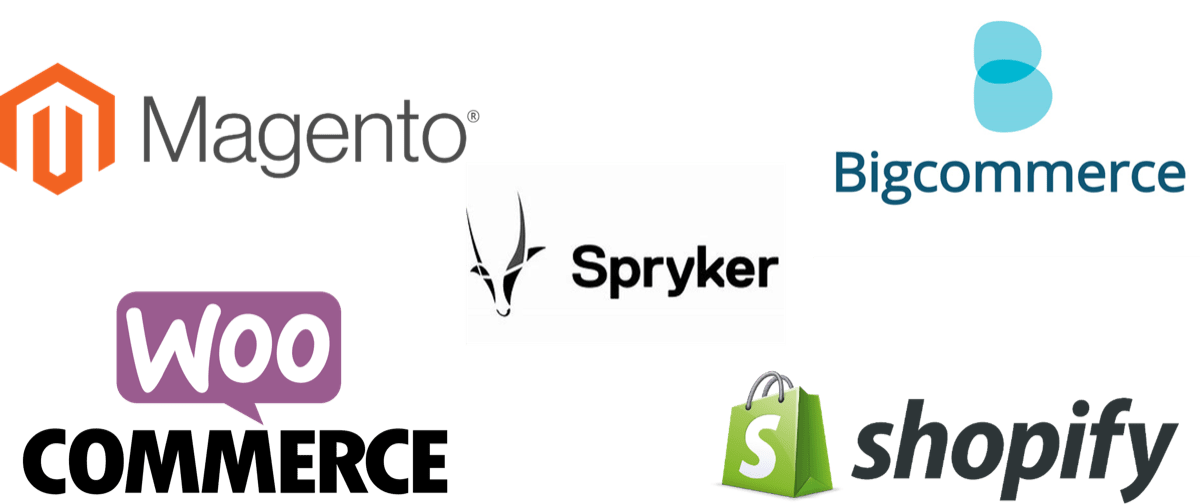
E-Commerce Vendor Snapshot: Part 2
Large Enterprise and Full-Suite E-Commerce Platforms
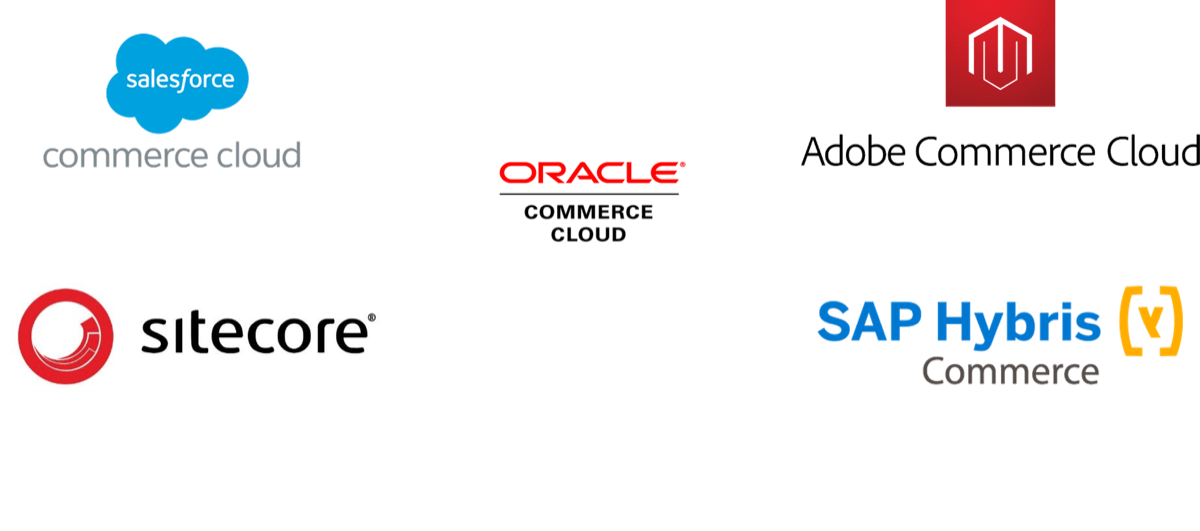
Speak with category experts to dive deeper into the vendor landscape
- Fact-based reviews of business software from IT professionals.
- Product and category reports with state-of-the-art data visualization.
- Top-tier data quality backed by a rigorous quality assurance process.
- User-experience insight that reveals the intangibles of working with a vendor.
Software Reviews is powered by Info-Tech
Technology coverage is a priority for Info-Tech, and SoftwareReviews provides the most comprehensive unbiased data on today’s technology. The insights of our expert analysts provide unparalleled support to our members at every step of their buying journey.
CLICK HERE to access SoftwareReviews Comprehensive software reviews to make better IT decisions.
We collect and analyze the most detailed reviews on enterprise software from real users to give you an unprecedented view into the product and vendor before you buy.
Evaluate software category leaders through vendor rankings and awards
SoftwareReviews
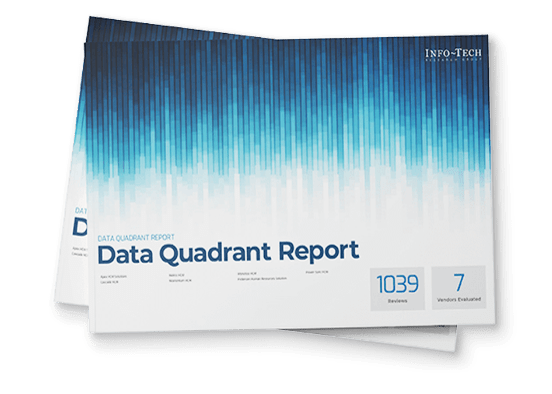
The Data Quadrant is a thorough evaluation and ranking of all software in an individual category to compare platforms across multiple dimensions.
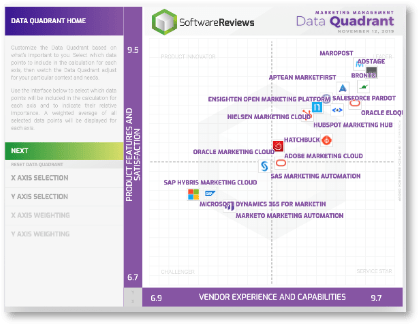
Vendors are ranked by their Composite Score, based on individual feature evaluations, user satisfaction rankings, vendor capability comparisons, and likeliness to recommend the platform.
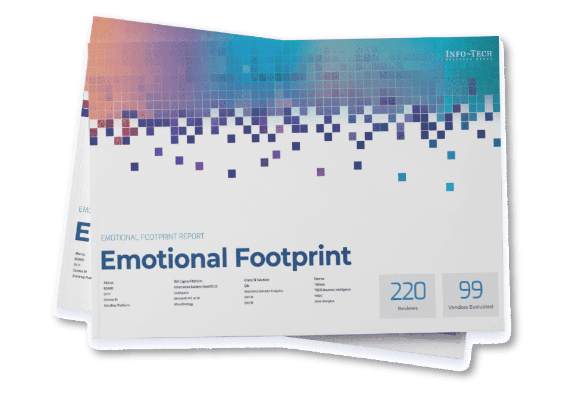
The Emotional Footprint is a powerful indicator of overall user sentiment toward the relationship with the vendor, capturing data across five dimensions.
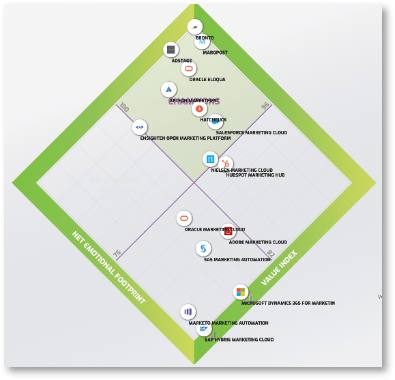
Vendors are ranked by their Customer Experience (CX) Score, which combines the overall Emotional Footprint rating with a measure of the value delivered by the solution.
Leading B2B E-Commerce Platforms
As of February 2022
Data Quadrant
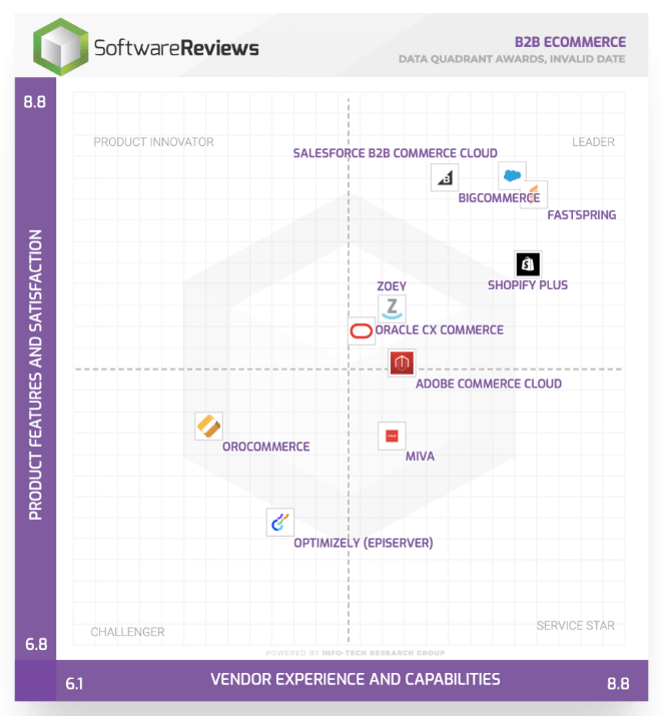
Emotional Footprint
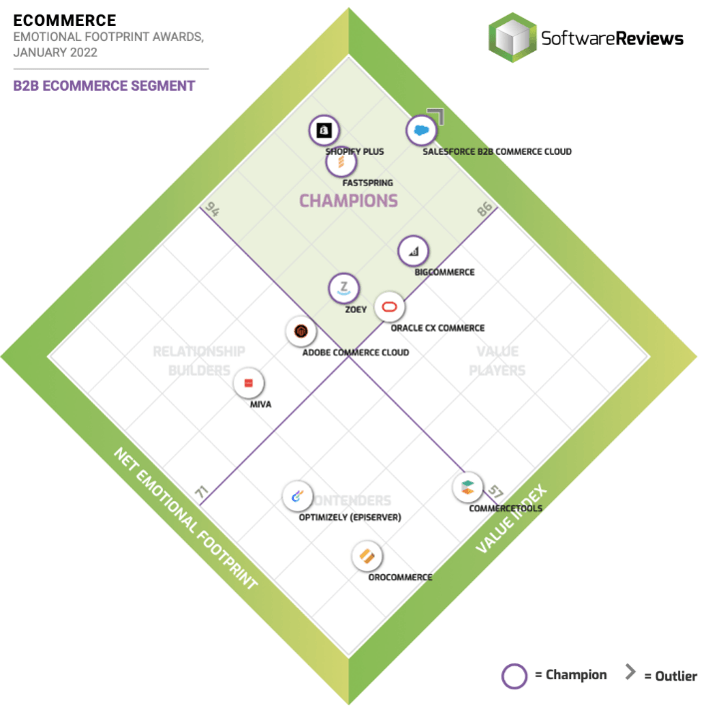
Leading B2C E-Commerce Platforms
As of February 2022
Data Quadrant
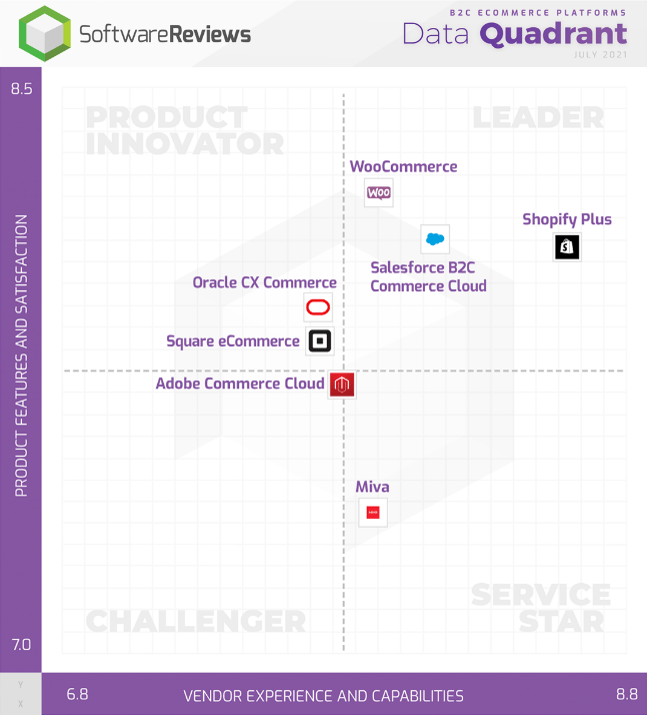
Emotional Footprint
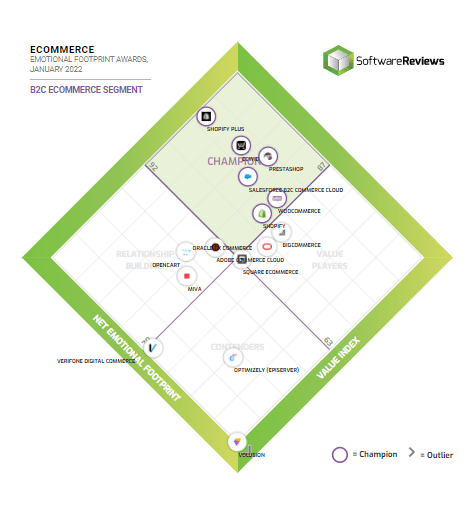
Application spotlight: point-of-sale solutions
How It Enables Your Strategy
- Point-of-sale solutions provide capabilities for cash register/terminal management, transaction processing, and lightweight inventory management.
- Many POS vendors also offer products that have the ability to create orders from EDI, phone, or fax channels.
- An increasing emphasis has been placed on retail analytics by POS vendors – providing reporting and analysis tools to help with inventory planning, promotion management, and product recommendations.
- Integration of POS systems with a central customer data warehouse or other system of record for customer information allows for the ability to build richer customer profiles and compare shopping habits in physical stores against other transactional channels that are offered.
- POS vendors often offer (or integrate with) loyalty management solutions to track, manage, and redeem loyalty points. See this note on loyalty management systems.
- Legacy and/or homegrown POS systems tend to be an area of frustration for customer experience management modernization.
Key Trends
- POS solutions are moving from “cash-register-only” solutions to encompass mobile POS form factors like smartphones and tablets. Vendors such as Square have experienced tremendous growth in opening up the market via “mPOS” platforms that have lower costs to entry than the traditional hardware needed to support full-fledged POS solutions.
- This development puts robust POS toolsets in the hands of small and medium businesses that otherwise would be priced out of the market.
POS KPIs
Strong POS applications can improve:
- Customer Data Collection
- Inventory or Cash Shrinkage
- Cost per Transaction
- Loyalty Program Administration Costs
- Cycle Time for Transaction Execution
Point-of-Sales Vendor Snapshot: Part 1
Mid-Market POS Solutions
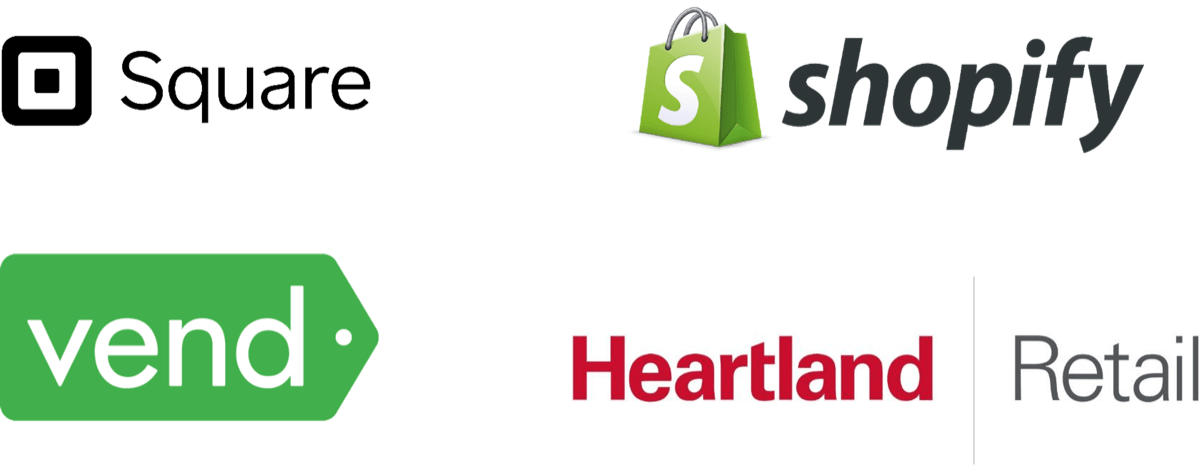
Point-of-Sales Vendor Snapshot: Part 2
Large Enterprise POS Platforms
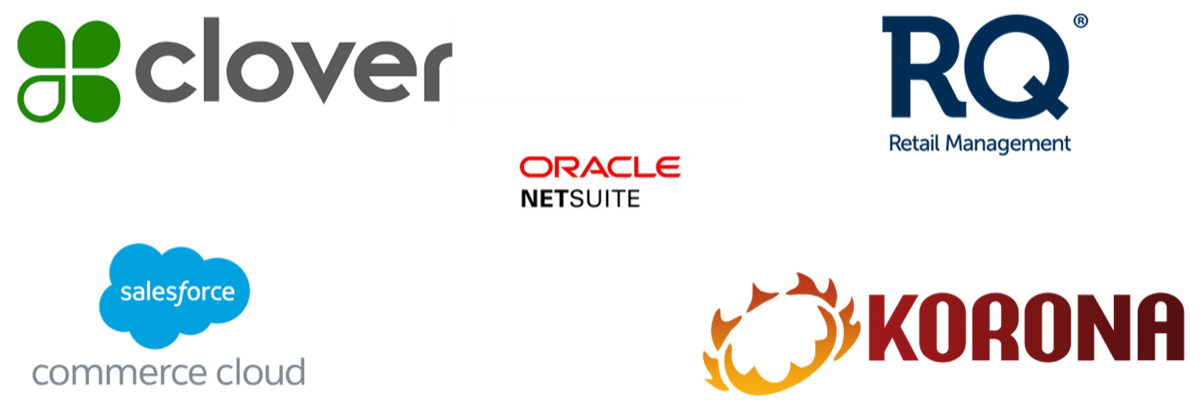
Leading Retail POS Systems
As of February 2022
Data Quadrant
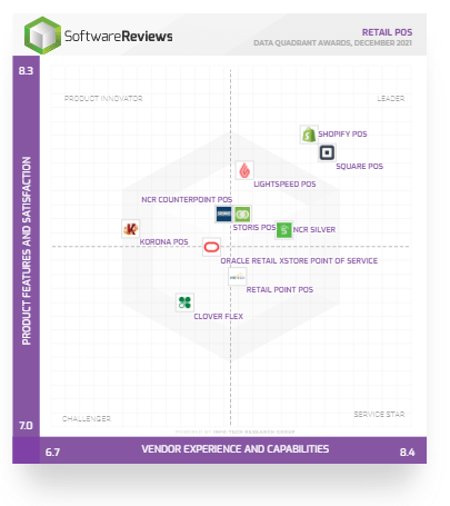
Emotional Footprint
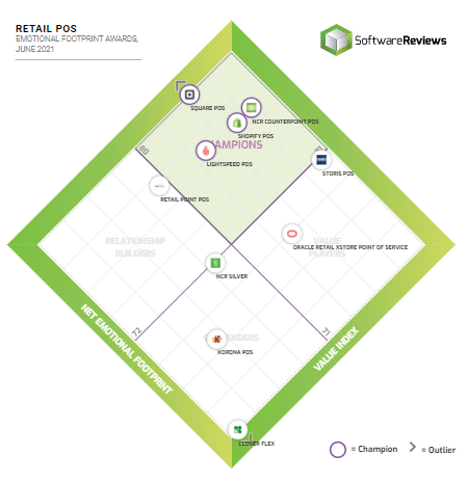
Summary of Accomplishment
Knowledge Gained
- Commerce channel framework
- Customer affinities
- Commerce channel overview
- Commerce-enabling technologies
Processes Optimized
- Persona definition for commerce strategy
- Persona channel shortlist
Deliverables Completed
- Customer personas
- Commerce user scenarios
- Business drivers for traditional commerce and e-commerce
- Channel matrix for omnichannel commerce
Bibliography
“25 Amazing Omnichannel Statistics Every Marketer Should Know (Updated for 2021).” V12, 29 June 2021. Accessed 12 Jan. 2022.
“Amazon Go.” Amazon, n.d. Web.
Andersen, Derek. “33 Statistics Retail Marketers Need to Know in 2021.” Invoca, 19 July 2021. Accessed 12 Jan. 2022.
Andre, Louie. “115 Critical Customer Support Software Statistics: 2022 Market Share Analysis & Data.” FinancesOnline, 14 Jan. 2022. Accessed 25 Jan. 2022.
Chuang, Courtney. “The future of support: 5 key trends that will shape customer care in 2022.” Intercom, 10 Jan. 2022. Accessed 11 Jan. 2022.
Cramer-Flood, Ethan. “Global Ecommerce Update 2021.” eMarketer, 13 Jan. 2021. Accessed 12 Jan. 2022.
Cramer-Flood, Ethan. “Spotlight on total global retail: Brick-and-mortar returns with a vengeance.” eMarketer, 3 Feb. 2022. Accessed 12 Apr. 2022.
Fox Rubin, Ben. “Amazon now operates seven different kinds of physical stores. Here's why.” CNET, 28 Feb. 2020. Accessed 12 Jan. 2022.
Krajewski, Laura. “16 Statistics on Why Omnichannel is the Future of Your Contact Center and the Foundation for a Top-Notch Competitive Customer Experience.” Business 2 Community, 10 July 2020. Accessed 11 Jan. 2022.
Manoff, Jill. “Fun and convenience: CEO Nany Green on Old Navy’s priorities for holiday.” Glossy, 8 Dec. 2020. Accessed 12 Jan. 2022.
Meola, Andrew. “Rise of M-Commerce: Mobile Ecommerce Shopping Stats & Trends in 2021.” Insider, 30 Dec. 2020. Accessed 12 Jan. 2022.
“Outdoor apparel retailer Icebreaker uses AI to exceed shopper expectations.” Salesforce, n.d.(a). Accessed 20 Jan. 2022.
“Personas.” Usability.gov., n.d. Web. 28 Aug. 2018.
“PetSmart – Why Commerce Cloud?” Salesforce, n.d.(b). Web. 30 April 2018.
Toor, Meena. “Customer expectations: 7 Types all exceptional researchers must understand.” Qualtrics, 3 Dec. 2020. Accessed 11 Jan. 2022.
Westfall, Leigh. “Omnichannel vs. multichannel: What's the difference?” RingCentral, 10 Sept. 2021. Accessed 11 Jan. 2022.
“Worldwide ecommerce will approach $5 trillion this year.” eMarketer, 14 Jan. 2021. Accessed 12 Jan. 2022.